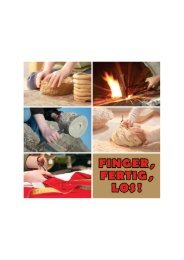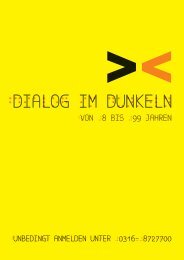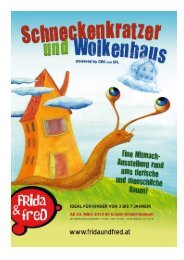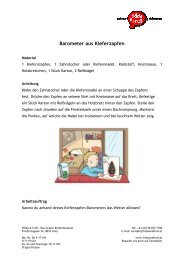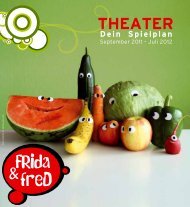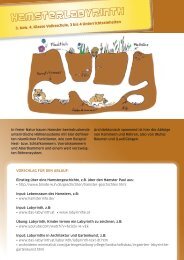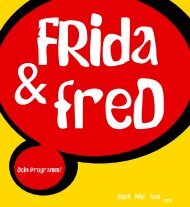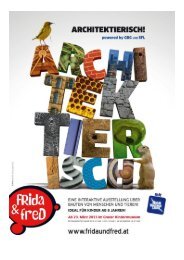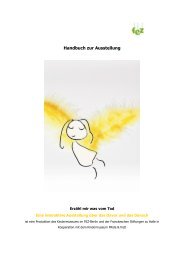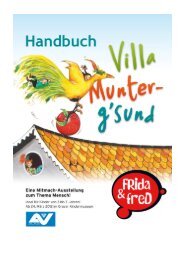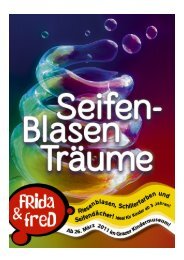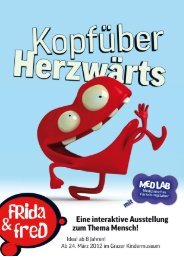Heart over Heels - FRida & freD
Heart over Heels - FRida & freD
Heart over Heels - FRida & freD
Create successful ePaper yourself
Turn your PDF publications into a flip-book with our unique Google optimized e-Paper software.
<strong>FRida</strong> & <strong>freD</strong> travelling exhibitions presents<br />
<strong>Heart</strong> <strong>over</strong> <strong>Heels</strong><br />
(c) Günther Linshalm / <strong>FRida</strong> & <strong>freD</strong><br />
Through movement children find out more about the complex theme of the human body and about<br />
themselves, their needs, abilities and desires.<br />
Target group<br />
Concept – in search of yourself<br />
The house and theme rooms – the human being as an interactive living space<br />
Step by step with the “feel at home” card<br />
Spatial and technical requirements<br />
Dates and Prices<br />
Contact<br />
Photos
HEART OVER HEELS<br />
Target group<br />
<strong>Heart</strong> <strong>over</strong> <strong>Heels</strong> is designed for children six years and older visiting with families or groups. The<br />
diversity of rooms is also suitable for preschoolers to explore.<br />
CONCEPT<br />
In search of yourself<br />
<strong>Heart</strong> <strong>over</strong> <strong>Heels</strong> addresses the theme of the human body. While the human body is often displayed<br />
as a functional machine in its every detail, visitors of <strong>Heart</strong> <strong>over</strong> <strong>Heels</strong> are not shown descriptive<br />
diagrams or charts in order to increase their awareness of the subject. Instead, they participate in<br />
movement-based activities that lead them down the path to self-disc<strong>over</strong>y. The more familiar<br />
children become with themselves and the greater their sense of self, the more deliberately and<br />
efficiently they can live their everyday lives. The children are encouraged to embrace a positive<br />
attitude about themselves. The focal point of this exhibition is the experience and exploration of<br />
oneself and the concept of “feeling at home in the world”. Questions are posed in a way that<br />
motivates the children to find answers on their own. They are encouraged to challenge who and<br />
what they think they are, what they like and don’t like, and what it takes in order to feel good in<br />
their own skin.<br />
The visitors:<br />
… learn how the body functions through hands-on experiences<br />
… create an image of themselves in the process<br />
… disc<strong>over</strong> themselves and identify their needs<br />
… understand and conquer their world.<br />
Understanding oneself and the environment through movement<br />
Children move according to their own desires and impulses, and conquer their world through a<br />
continuously growing repertory of movement. They run, jump, summersault, climb, throw, and<br />
balance. In response to children’s urge to move, <strong>Heart</strong> <strong>over</strong> <strong>Heels</strong> contains numerous movement-<br />
based activities, which test their motor skills and coordination, such as their reflexes, balance,<br />
flexibility, speed, sense of rhythm, and the endurance and quickness of their arms and legs.<br />
2
THE HOUSE AND THE THEME ROOMS<br />
The human being as an interactive living space<br />
Everyday, children ask themselves – and others – questions about the human body.<br />
“What happens with my food after I’ve swallowed it?”<br />
“Why does my heart sometimes beat faster?”<br />
“Why do I get a side stitch when I run fast?”<br />
Questions about “themselves” arise at every possible hour but most frequently when children have<br />
disc<strong>over</strong>ed an anatomic function or need.<br />
In order to keep body and mind together as one, while explaining several anatomic functions, we<br />
have created the <strong>Heart</strong> <strong>over</strong> <strong>Heels</strong> exhibit in the model of a house, hoping that this metaphor will<br />
more effectively draw attention to our human needs. Based on the fact that human beings –<br />
independent from sex, origin, social status and religion – furnish their living space according to their<br />
own specific needs and desires, this exhibition presents itself as an interactive educational living<br />
space, where every room addresses a specific aspect of “self”. The houses that people live in are as<br />
different as the people themselves.<br />
These interactive living spaces have each been designed to demonstrate different basic daily<br />
needs as well as to emphasise certain anatomic functions.<br />
The first noticeable thing when visiting <strong>Heart</strong> <strong>over</strong> <strong>Heels</strong> is the façade of the house. It consists of a<br />
collage of pictures, showing children in a variety of situations. This exemplifies the concept of the<br />
exhibition which aims to demonstrate just how diverse human beings really are.<br />
3
Kitchen and dining area<br />
The kitchen and dining area present an analogy of food processing within the household and inside<br />
the body. The kitchen c<strong>over</strong>s nutritional guidelines, the digestive system, and also acts as a central<br />
place where family members can communicate openly with one another. The nutritional guidelines<br />
reflect not only the consumption and processing of food, but also the importance of “nourishing” all<br />
of our daily requirements and needs.<br />
The jigsaw puzzle on the wallpaper symbolises the division of nutrients as they travel through the<br />
body during digestion - a whole is broken up and split into many little particles.<br />
The pictures in this room show illustrated expressions, such as “Do things ever get stuck in your<br />
throat?”, or “Are some things hard for you to stomach?”<br />
Kitchen cupboards<br />
Children are taught how an apple is digested by crawling through the kitchen cupboards.<br />
Nutritious card game<br />
In this game, the nutritional guidelines share the main focus with the daily meals, which represent<br />
the daily communication between family members. The objective of this game is to “fill your<br />
plate”, and to “eat” in such a way that you stay full for as long as possible.<br />
“I decide!”<br />
The visitors are presented with the question “What do I like?” and then asked to choose between<br />
the two buttons, “Yes, I like it!” or “No, I don’t like it!”<br />
Mud pie bakery<br />
Children bake mud pies.<br />
4
Bathroom and toilet<br />
The bathroom and toilet present themselves as a collage of different cleansing systems. As the<br />
counterpart to ingesting kitchen, the central theme of the bathroom is “giving up”. This part of the<br />
exhibit addresses the issues of inner and outer cleansing.<br />
Water, the cleansing element, is pictured beneath a fine filter as an illustration of the function of<br />
our kidneys. Representing the two-thirds of water of which the human body is composed, the<br />
wallpaper in this room does not reach all the way to the ceiling.<br />
The pictures in this room answer several of the questions children commonly have about hygiene,<br />
such as “Do you want to know why you sweat sometimes?”, “Do you want to know where your pee<br />
comes from?”, “Do you want to know how diarrhoea happens?”, …<br />
Bathtub game<br />
The human body balances its water supply through consumption (food and beverage) and expulsion<br />
(urine, faeces, sweat, tears, saliva).<br />
Collage of mirrored cabinet doors<br />
Several pictures and a short film about animals that clean themselves are hidden behind the doors<br />
of a mirrored cabinet.<br />
Quacky sound collage<br />
Little rubber ducks create different bathroom sounds while swimming in a sink.<br />
Toilet flushing game<br />
The children can release themselves from any unwanted aspects of their life by writing them on a<br />
little piece of paper and flushing them down the toilet – by doing so they activate a sound<br />
installation.<br />
Toothbrush game<br />
Armed with a toothbrush, the children try to catch the little cavity monsters that take up residence<br />
in the mouth after eating.<br />
Loo-literature about release and expulsion<br />
5
Boiler room<br />
The main feature of this room is a big red tube slide which symbolises the digestive tract of the<br />
human body and links the kitchen to the bathroom. The entrance of this slide is accessible through<br />
the last kitchen cupboard and it exits directly in front of the toilet. The heart is also discussed in<br />
this room since the digestive tract is responsible for delivering nutrients to the bloodstream, thus<br />
producing new energy.<br />
The wallpaper of the boiler room features a vast network of veins in warm red tones.<br />
The pictures provide answers to questions, including: “Do you want to know what your heart<br />
does?”, “Do you want to know why you blush sometimes?”, “Do you want to know why nutrients that<br />
you ingest are absorbed by the blood?”.<br />
Furnace<br />
Children, coming from the kitchen, crawl and climb through the slide which simulates the digestive<br />
tract, pushing balls forward and throwing them into holes in the boiler room. This demonstrates to<br />
the children that the absorption of nutrients into the bloodstream happens directly within the<br />
digestive tract. In the boiler room they load the balls into an oven in order to generate heat.<br />
Pulse check<br />
The children can monitor and record their heart beat using an electronic stethoscope.<br />
Pump station<br />
A child’s daily routine is shown in a film, revealing the fluctuation of the heart rate throughout<br />
various everyday activities and situations. The children exercise on a stair stepper keeping time<br />
with the film and by doing so increase their heart rate.<br />
6
Nursery<br />
The nursery displays the uniqueness of each individual. It shows what human beings are made of and<br />
what makes them so special.<br />
The wallpaper is a collage of eggs, which at first glance all appear identical. On closer examination,<br />
however, you can see that no two eggs are exactly alike.<br />
The pictures in this room illustrate the different phases of growth and development.<br />
Detective profiling<br />
In this game the children are on a search for themselves. In a special detective passport, they<br />
record all the information they have unc<strong>over</strong>ed about themselves: their interests, hair colour,<br />
favourite colour, fingerprints, eye colour, mother-tongue, skin colour, shoe size, sex, weight and<br />
height.<br />
7
Living room<br />
In the living room, visitors of all ages are given the chance to disc<strong>over</strong> their current needs and<br />
requirements and how to react to them, as needs often trigger a variety of actions. The main steps<br />
towards doing so are paying special attention to their personal needs, articulating them and<br />
developing a strategy by which to fulfil them.<br />
The motif of the wallpaper first seems to be comprised of a collection of suns but from a closer<br />
look, it becomes clear that one is actually looking at an ensemble of cacti. Both are symbols,<br />
respectively, for “feeling at home” and “not feeling at home”.<br />
In the pictures in the living room, some of the non-materialistic wishes of children are written, such<br />
as “I want to have breakfast in bed with my parents!”, “I want to build a dam in the stream with<br />
branches and stones!”, “I want to be asked about my opinion!”.<br />
Televised need fulfilment<br />
By television, this game presents several human needs to children. The task at hand is to find a<br />
suitable strategy by which to satisfy these needs.<br />
Dollhouse – Furnishing for comfort<br />
Working with their parents, our young visitors furnish a dollhouse with the goal of making it homey<br />
and comfortable.<br />
Big comfortable reading corner with a small library of books about the human body<br />
8
Coat room<br />
In the coat room the children feel free to act themselves and present their identity outwardly to<br />
others.<br />
On the wallpaper two zebras are pictured, one that blends in with its environment, while the other<br />
contrasts against its background.<br />
The pictures in this room all relate to the topic of body language.<br />
Costume grab<br />
The children can choose from different costumes: winter clothes, swimwear, leisure outfits and<br />
school uniforms.<br />
Twisted mirror<br />
A mirror that distorts reality.<br />
Obstacle course<br />
Little trip blocks and obstacles have been integrated to increase the challenge of walking down the<br />
catwalk.<br />
World stage<br />
In front of large curtains which display pictures of children wearing clothes of a common theme, the<br />
visitors can choose either to adopt or go against the suggested theme.<br />
Three-part collapsible costumes<br />
Different costumes can be combined together in a three-part collapsible picture-book.<br />
9
Study<br />
The study deals with the rational conscious of the human mind – thinking, learning and expanding<br />
our knowledge. A collection of writing desks, each with different tasks to carry out, point to a<br />
variety of cognitive possibilities.<br />
The pattern on the wallpaper consists of the topics: brain, synaptic impulse and perception. The<br />
text is written in a swirling pattern (“something spins around in my head”) in direct association with<br />
the neuralgia of the brain.<br />
To encourage the children to find their own answers to the numerous questions about the human<br />
body, each picture shows a question along with three possible answers; the correct answers are<br />
hidden on the back of the picture frame.<br />
Writing table collage<br />
The writing tables symbolise the two hemispheres of the brain, and through a variety of games, the<br />
delineations between the two hemispheres are made apparent.<br />
Walnuts and nutcracker collection<br />
The human brain is similar in shape to a walnut. At this station the children can choose from a<br />
collection of different nutcrackers, all which function in different ways, to crack and eat walnuts.<br />
A wall of specialised books pertaining to the theme of the human body, accompanied by a listening<br />
station “We disc<strong>over</strong> our body”<br />
Intertwined nerve ends<br />
The message system integrated into the study demonstrates the strong network of the body’s<br />
nerves.<br />
10
Winter garden<br />
The winter garden symbolises perception through the use of all human senses. The emphasis in this<br />
room is on perceiving and feeling rather than attempting to describe the human body rationally as a<br />
collection of parts. In this exhibition, the children can give wide-eyed stares, prick their ears, turn<br />
up their noses, taste-test all kinds of things and in doing so, carefully poke around the entire place.<br />
The chakra coloured wallpaper in this room hints at the search for the sixth sense!<br />
The pictures in the winter garden show the Müller-Lyer illusion, the Tichener’s circle illusion, the<br />
Lipp illusion and motion perception.<br />
Eye glasses<br />
The children can experience their environment through different kinds of glasses (microscope<br />
glasses, coloured glasses, up/down glasses, left/right glasses and many more).<br />
Hand-eye-coordination<br />
The hand-eye-coordination test is an exercise where visitors can test their hand to eye coordination<br />
skills and reaction time.<br />
Camera Obscura<br />
The functionality of the eyes is explained with the help of Camera Obscura.<br />
Through animal eyes<br />
By asking the children the question, “How do you see an animal and how does an animal see you?”<br />
we confront them with the idea that a human is more than it first appears to be …<br />
Ear sport<br />
The children play ear sport by following a text that is consecutively audible from different<br />
loudspeakers.<br />
Sound wave transmission<br />
The transmission of sounds is explained through the beating of the membrane on a drum, as that is<br />
how the sound waves are produced. These sound waves then collide with the blinds hanging in a<br />
nearby window, and set them into motion.<br />
11
Directional hearing<br />
Here the children try to determine what direction a sound is coming from while holding two<br />
connected funnels up to their ears. While one person listens, a second person taps lightly on the<br />
pipe connecting the funnels. The listener then tries to find out whether the sound is coming from<br />
the right or left side.<br />
Balancing bar<br />
On a small balancing bar the young visitors practice their balance.<br />
Hearing test<br />
After taking a simple hearing test, the children find out if they are able to differentiate between<br />
similar sounding words by selecting the illustrations that match the words they hear.<br />
Seashells<br />
An analogy is made between small and large seashells and the shape of our ears.<br />
Lip reading<br />
This installation shows that words can also be perceived and understood visually.<br />
Scent trail<br />
Just follow your nose when sniffing along a “scent trail”.<br />
Sniffing booths<br />
We have sniffing booths for our small visitors, in which they can smell various scents that each<br />
provoke a different association.<br />
“What do you sense and how does it make you feel?”<br />
This installation clarifies that sensing is not synonymous to feeling. The fairly objective exploration-<br />
perception indicates what is sensed, while the rather subjective sensation-perception provides the<br />
child with an opportunity to express whether he or she feels good or bad.<br />
Gloves<br />
12
While trying on different types of gloves, the fine and gross motor skills are tested. These tests are<br />
task-based and involve performing gloved activities such as stacking building blocks and fine<br />
needlework techniques.<br />
Degustation bar<br />
To try out the different tastes of sweet, sour, salty and bitter, flavoured waters are provided to our<br />
visitors in order for them to experience these tastes firsthand.<br />
Skin pattern<br />
“Clothes” made out of patterns reminiscent of winter coats, rain cloaks and blinds, make it possible<br />
to explore the entire surface of the skin.<br />
13
Bedroom<br />
Relaxation, rest and repose – these are most important themes of the bedroom. In a very<br />
comfortable room with a cupola, the children are invited to slow down and relax. A starry sky,<br />
relaxing herb-filled cushions, books, screens with images of yawning people, soft acoustics, listening<br />
stations with stories for dreaming, and installations that make it possible to literally count sheep;<br />
all offer the children the chance to retreat from everyday life.<br />
The wallpaper, in a luscious monochrome blue, has a tranquilising effect on its visitors.<br />
The pictures in the bedroom display bedtime stories as well as nursery rhymes.<br />
Soothing oasis with a starry sky, herb filled cushions, bedtime stories and books<br />
Soothing oasis with pulsing lights and the sounds of lapping waves at the seashore<br />
Soothing oasis with the “counting sheep” installation and toys to cuddle with while they doze<br />
14
Balcony<br />
The topics addressed on the balcony are: conscious breathing, the capacity and functions of our<br />
lungs, as well as a comparison of “good” versus “bad” air.<br />
The wallpaper on the balcony was designed in the light colours of blue and white, and points out<br />
the striking similarity between a vastly interconnected bronchial-tree and a leafless tree in<br />
wintertime.<br />
The pictures in this room inspire the visitors to experiment with the element - air.<br />
Breezy journey into the lungs<br />
With “breath-powered interfaces” the children operate the game, tracing the path of an oxygen<br />
atom into the bloodstream, and a CO² molecule’s journey into the air.<br />
Deck chair cave<br />
The visitors realise that it is difficult to concentrate in stale “bad” air, while trying to assemble a<br />
multilayer puzzle from within the deckchair cave.<br />
Bicycle tour into the forest<br />
Here the children can test their athletic endurance, while the importance of fresh air is pointed<br />
out.<br />
Lung capacity test<br />
From a simple test – blowing into a water-filled container – the children find out more about the<br />
capacity of their lungs.<br />
15
Fitness room<br />
The central theme in <strong>FRida</strong> & <strong>freD</strong>’s fitness room is movement. That is why there are numerous<br />
interactive installations that assess the body’s movement. The fitness room also explores the bones,<br />
joints and muscles of the human body.<br />
The vertical zigzag on the wallpaper creates the illusion of motion – “Move your body while<br />
exploring yourself!”<br />
The pictures in this room show motion sequences, such as the bending and lengthening of arms and<br />
legs.<br />
Jigsaw puzzle “Bones and skeletal structures”<br />
Once assembled, the puzzle depicts a scene indicating that human beings are not the only life forms<br />
with a supportive skeletal frame.<br />
Dancing Test<br />
With their natural rhythmic ability, the children do their best to follow the pattern set by jumping<br />
feet on the monitor.<br />
Joints<br />
To encourage the children to disc<strong>over</strong> the different types of joints by themselves, there are three-<br />
dimensional mechanical models of each type of joint, as well as illustrations of the entire human<br />
body.<br />
Sprint<br />
On a three meter long running track the children test their speed.<br />
Facial muscles<br />
A film is shown behind a one-way mirror that makes it possible to simultaneously observe and mimic<br />
the grimaces of a clown.<br />
Wallball<br />
The children test the quickness of their arms, by throwing a 0.5 kg ball at a target on the wall.<br />
16
Animal shadows<br />
Through hand gestures the visitors imitate the shape and movement of several animals.<br />
17
Garage<br />
In the garage many objects are being worked on; broken objects are repaired while well functioning<br />
objects are reinforced and strengthened. That is why this room includes topics such as injury and<br />
illness. The central theme of the garage is the acknowledgment of the dangers in our everyday<br />
lives, accompanied by a variety of healing remedies.<br />
On the wallpaper in this room, huge plasters are presented in spring-colours which symbolise the<br />
themes of: regeneration, healing and prevention.<br />
The pictures in the garage contain recipes for healthy vegetable juices.<br />
Medicine cabinet<br />
In the drawers of a medicine cabinet, the children disc<strong>over</strong> photos of different healing remedies as<br />
well as a variety of treatment possibilities.<br />
Sick ward<br />
Here, the children can treat and heal dolls and toys with real medical equipment. By taking these<br />
tools into their own hands, the children lose their fears and anxieties about being treated by others<br />
with them.<br />
Refreshment bar<br />
The children strengthen themselves at the water-bar by drinking a glass of humour, tranquillity,<br />
friendship, acceptance, movement, protection or nutrition.<br />
CD-Rom security bear<br />
By playing this CD-Rom the visitors are made aware of the dangers in household, garden, play<br />
ground, traffic and sporting activities.<br />
18
Cellar<br />
The cellar is a room where things are continually collected, piled up and stored. Thus its main<br />
purpose is that of a repository or storage unit. Similarly, people store many things inside themselves<br />
where they can be accessed again later on. Memories and reflections of one’s past can be such<br />
meaningful reserves that one can be sustained by them for a long time. Suited to the usual<br />
challenges of a cellar – efforts to reach something that’s been placed at the top or the back of a<br />
high shelf – there are two exercises integrated in this room as a test of the visitors’ motor skills.<br />
There are two motifs on the wallpaper in this room which <strong>over</strong>lap each other – a sponge and a<br />
honeycomb. These motifs reinforce the humans capacity to store input.<br />
The pictures in the cellar provide information about what humans store.<br />
Quickness of the legs<br />
Here the children reach up to push a button. Then they jump up and push another button. It is in<br />
this way that they disc<strong>over</strong> the power of their legs, and determine whether they have a lot of<br />
power, extreme power or tremendous power in their legs.<br />
Flexibility<br />
The young visitors try to reach a button near their toes with outstretched legs and in this manner<br />
experiment with their flexibility.<br />
Memory bank<br />
Humans store many memories. This memory-recall phenomenon is demystified for the visitors<br />
through the use of mnemotechnics.<br />
19
Hallway<br />
As the common link between the rooms, the wallpaper in the hallway depicts the extensive network<br />
of blood vessels, arteries and nerves.<br />
The pictures in the hallway are composed of puzzles and riddles that draw specific attention to<br />
several human needs and requirements.<br />
20
Step by step with the “feel at home” card<br />
The “feel at home” card can be used at 17 different interactive installations. With their card,<br />
children can save pictures of themselves, collect the results from their sport activities, or dive<br />
deeper into the subject of the human body by asking further questions.<br />
Using their personal passwords, the visitors can log on to our website and relive their visit of “<strong>Heart</strong><br />
<strong>over</strong> <strong>Heels</strong>” at home.<br />
21
Spatial and technical requirements<br />
Required surface area: 400 m² to 600 m²<br />
Minimum room height: 2.80 m<br />
<strong>Heart</strong> <strong>over</strong> <strong>Heels</strong> is composed of 3.2 x 4.8 meter rooms plus hallway and is extremely adaptable to<br />
fit nearly any exhibit space.<br />
Setup options for:<br />
o a room with a width of 10 meters<br />
o a room with a width of 15 meters<br />
o an almost square room<br />
o a two-level exhibit<br />
o a three-level exhibit<br />
The house complex is composed of a pipe rack with attachable tarpaulins, and is a free-standing<br />
structure. For this reason, it is also suitable if assembly to the existing architecture is not possible.<br />
Sufficient energy supply and internet access is required. Technical equipment is included with the<br />
delivery of the exhibit.<br />
Dates and prices<br />
€ 18,025.00 / month plus the costs of put-up and take-down, training and transportation<br />
Minimum borrowing duration is 6 months.<br />
Contact<br />
Mag.a Bettina Deutsch-Dabernig<br />
E-Mail: bettina.deutsch-dabernig@stadt.graz.at<br />
Tel: +43 (0)316/872 7707<br />
22
Photos<br />
All photos (c) Günther Linshalm / <strong>FRida</strong> & <strong>freD</strong><br />
23



